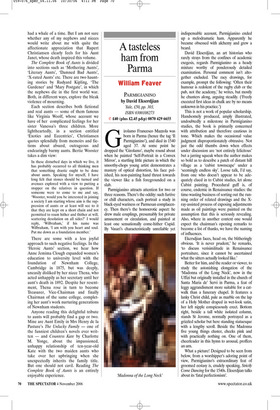A tasteless ham from Parma
William Feaver
PARMIGIANINO by David Ekserdjian Yale, £50, pp. 303, ISBN 0300108273 ✆ £40 (plus £2.45 p&p) 0870 429 6655 Girolamo Francesco Mazzola was born in Parma (hence the tag ‘Il Parmigianino’), and died in 1540 aged 37. At some point he dropped the ‘Girolamo’, maybe round about when he painted ‘Self-Portrait in a Convex Mirror’, a startling little picture in which the smoothy-chops young artist demonstrates a mastery of optical distortion, his face polished, his non-painting hand thrust towards the viewer like a fish foregrounded on a slab.
Parmigianino attracts attention for two or three reasons. There’s the oddity: such furtive or chill characters, each portrait a study in black-eyed wariness or Parmesan complacency. Then there’s the homoerotic aspect: he drew male couplings, presumably for private amusement or circulation, and painted at least one sensationally come-hither Cupid. By Vasari’s characteristically unreliable yet indispensable account, Parmigianino ended up a melodramatic ham. Apparently he became obsessed with alchemy and grew a beard.
David Ekserdjian, an art historian who rarely strays from the confines of academic exegesis, regards Parmigianino as a heady mixture worthy of ponderously detailed examination. Personal comment isn’t altogether excluded. The racy drawings, for example, prompt the following: ‘Often their humour is redolent of the rugby club or the pub, not the academy,’ he writes, but mostly he chunters along, arguing steadily. (‘Freely executed first ideas in chalk are by no means unknown in his practice.’) This is not a work of popular scholarship. Handsomely produced, amply illustrated, undoubtedly a milestone in Parmigianino studies, the book is primarily concerned with attribution and therefore cautious in tone. Which makes the occasional value judgment disproportionately obtrusive. Not just the odd thumbs down when effects under discussion are ‘not entirely felicitous’ but a jarring squeak when the author makes so bold as to describe a patch of distant hill village as a ‘cubist townscape’ under a ‘seemingly endless sky’. Loose talk, I’d say, from one who doesn’t appear to be adequately clued in to Cubist studies, let alone Cubist painting. Procedural guff is, of course, endemic in Renaissance studies: the time-wasting business of sorting out the running order of related drawings and the Xray-assisted process of exposing adjustments made as oil paintings were painted on the assumption that this is seriously revealing. Also, where in another context one would expect the chairman’s opening remarks to become a list of thanks, we have the naming of influences.
Ekersdjian faces, head on, the blitheringly obvious. ‘It is never prudent,’ he remarks, ‘to discuss verisimilitude in Renaissance portraiture, since it cannot be ascertained what the sitters actually looked like.’ Better for him, and the reader or viewer, to study the astonishing elongation of the ‘Madonna of the Long Neck’, now in the Uffizi but originally installed in the church of Santa Maria de’ Servi in Parma, a feat of leggy aggrandisment more suitable for a catwalk than a funerary chapel. It features a lanky Christ child, pale as marble on the lap of a Holy Mother draped in wet-look satin, her left nipple conspicuously erect. Bottom right, beside a tall white isolated column, stands St Jerome, normally portrayed as a grizzled scholar but here standing statuesque with a lengthy scroll. Beside the Madonna five young things cluster, cheeks pink and with practically nothing on. One of them, cheerleader in this hymn to arousal, proffers an urn.
What a picture! Designed to be seen from below, from a worshipper’s adoring point of view, Parmigianino’s extraordinary feat of groomed ecstasy is, crudely speaking, Strictly Come Dancing for the 1540s. Ekserdjian talks about its ‘fatal perfectionism’.


















































































































 Previous page
Previous page